

Panamint Springs is private resort in Inyo County, California. [1] It consists of a motel, cabins, RV and tent campsites, restaurant, and gas station, all operated by Cassell Enterprises, LLC. [1] It lies at an elevation of 1926 feet (587 m). [2]


Panamint Springs is private resort in Inyo County, California. [1] It consists of a motel, cabins, RV and tent campsites, restaurant, and gas station, all operated by Cassell Enterprises, LLC. [1] It lies at an elevation of 1926 feet (587 m). [2]
Panamint Springs Resort is located along State Route 190 (SR190) between Old Toll Road and Panamint Valley Road. The closest store and gas station to Star Wars Canyon, [3] the site features a motel, campground, restaurant, and the last gas station for many miles in either direction on SR190.
Although not official by the Board of Geographic Names, Caltrans calls the SR190/Panamint Valley Road intersection 2.5 driving miles east of Panamint Springs Panamint Junction. Towne Pass, a landmark when traveling to Death Valley, is 13.9 driving miles east on SR190. Beyond the pass, SR190 descends about 5,000 feet (1,500 m) to the dry bed of Lake Manly.
The Darwin Falls Wilderness, a U.S. Wilderness Area, is located just west of the resort. The nearby area also features the Darwin Falls, a small but scenic waterfall, grotto and creek that are the only year-round water supply in the driest part of North America; despite the similarly named wilderness, the falls are located in and administered by Death Valley National Park. The dirt road entryway to the trail to Darwin Falls is located ¼ mile west of the resort.
Panamint Springs Resort was originally owned and operated by Buffalo Bill Cody’s cousin, Agnes Cody and her husband W.A. Reid. [4] The motel was opened in 1937 when the first toll road was constructed traversing the Panamint Valley. A post office operated at Panamint Springs from 1940 to 1946, [5] but it no longer receives mail at all. [6] Ownership transferred to Peter and Elizabeth Clarkson in 1958 in a motel exchange with Agnes Reid. [7] In 1986 the managers found it too expensive to install telephone lines to the remote resort. [8] It has been owned by the Cassell Family since 2006. [5]
From 1989 to 1998 Panamint Springs Resort operated the Panamint Springs Airport at 36°20′17″N117°28′05″W / 36.338°N 117.468°W , just south of California State Route 190. Panamint Springs Airport had a single unpaved northeast/southwest runway. While not operated as an airport, the runway was still used for landing. [9]
From 1942 to 1945 the US Army operated the Panamint Spring Auxiliary Airfield at 36°22′12″N117°25′05″W / 36.37°N 117.418°W , 2 miles north of Route 190 on a dry lake bed. The runway was used for the training of World War II pilots. After the war, the runway was abandoned and no trace can be found today. [10]

Inyo County is a county in the eastern central part of the U.S. state of California, located between the Sierra Nevada and the state of Nevada. In the 2020 census, the population was 19,016. The county seat is Independence. Inyo County is on the east side of the Sierra Nevada and southeast of Yosemite National Park in Central California. It contains the Owens River Valley; it is flanked to the west by the Sierra Nevada and to the east by the White Mountains and the Inyo Mountains. With an area of 10,192 square miles (26,400 km2), Inyo is the second-largest county by area in California, after San Bernardino County. Almost half of that area is within Death Valley National Park. However, with a population density of 1.8 people per square mile, it also has the second-lowest population density in California, after Alpine County.

San Bernardino County, officially the County of San Bernardino and sometimes abbreviated as S.B. County, is a county located in the southern portion of the U.S. state of California, and is located within the Inland Empire area. As of the 2020 U.S. Census, the population was 2,181,654, making it the fifth-most populous county in California and the 14th-most populous in the United States. The county seat is San Bernardino.

Stovepipe Wells is a way-station in the northern part of Death Valley, in unincorporated Inyo County, California.

The Panamint Range is a short rugged fault-block mountain range in the northern Mojave Desert, within Death Valley National Park in Inyo County, eastern California. A small part of the southern end of the range is in San Bernardino County. Dr. Darwin French is credited as applying the term Panamint in 1860 during his search for the fabled Gunsight Lode.

Area codes 760 and 442 are telephone area codes in the North American Numbering Plan (NANP) for the U.S. state of California. These area codes serve an overlay complex that comprises much of the southeastern and southernmost portions of California. It includes Imperial, Inyo, and Mono counties, as well as portions of North County San Diego, Riverside, San Bernardino, Los Angeles and Kern counties. Area code 760 was created on March 22, 1997 in a split of area code 619. Area code 442 was added to the same area on November 21, 2009.
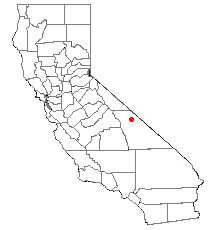
Saline Valley is a large, deep, and arid graben, about 27 miles (43 km) in length, in the northern Mojave Desert of California, a narrow, northwest–southeast-trending tectonic sink defined by fault-block mountains. Most of it became a part of Death Valley National Park when the park was expanded in 1994. This area had previously been administered by the Bureau of Land Management. It is located northwest of Death Valley proper, south of Eureka Valley, and east of the Owens Valley. The valley's lowest elevations are about 1,000 ft (300 m) and it lies in the rain shadow of the 14,000 ft (4,300 m) Sierra Nevada range, plus the 11,000 ft (3,400 m) Inyo Mountains bordering the valley on the west.
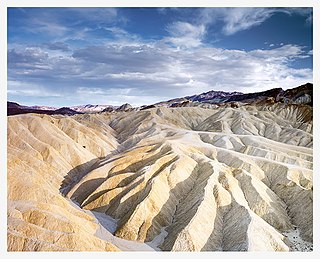
Places of interest in the Death Valley area are mostly located within Death Valley National Park in eastern California.
Searles Valley is a valley in the northern Mojave Desert of California, with the northern half in Inyo County and the southern half in San Bernardino County, California, United States.

Coso Hot Springs is a hot spring complex in the Coso Volcanic Field in the Mojave Desert of Inyo County, California. The Springs are on the National Register of Historic Places.
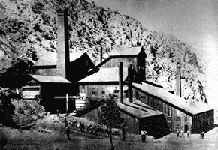
Panamint City is a ghost town in the Panamint Range, near Death Valley, in Inyo County, California, US. It is also known by the official Board of Geographic Names as Panamint. Panamint was a boom town founded after silver and copper were found there in 1872. By 1874, the town had a population of about 2,000. Its main street was one mile (1.6 km) long. Panamint had its own newspaper, the Panamint News. Silver was the principal product mined in the area. The town is located about three miles northwest of Sentinel Peak. According to the National Geographic Names Database, NAD27 latitude and longitude for the locale are 36°07′06″N117°05′43″W, and the feature ID number is 1661185. The elevation of this location is identified as being 6,280 feet AMSL. The similar-sounding Panamint Springs, California, is located about 25.8 miles at 306.4 degrees off true north near Panamint Junction.

The Argus Range is a mountain range located primarily in Inyo County, California, southeast of the town of Darwin. The range forms the western boundary of Panamint Valley, and the northwestern boundary of Searles Valley. The Coso Range is located to the west, and the Panamint Range to the east.
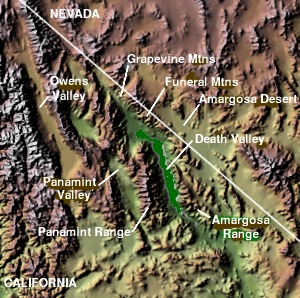
The Panamint Valley is a long basin located east of the Argus and Slate ranges, and west of the Panamint Range in the northeastern reach of the Mojave Desert, in eastern California, United States.

State Route 190 is a state highway in the U.S. state of California that is split into two parts by the Sierra Nevada. The western portion begins at Tipton at a junction with State Route 99 and heads east towards Porterville before ending at Quaking Aspen in the Sequoia National Forest. The eastern portion begins at US 395 southeast of Olancha, heads east through Death Valley National Park, and ends at State Route 127 at Death Valley Junction. The 43.0-mile (69.2 km) portion over the Sierra Nevada remains unconstructed, and the California Department of Transportation (Caltrans) has no plans to build it through the wilderness areas. SR 190 is a National Scenic Byway known as the Death Valley Scenic Byway.
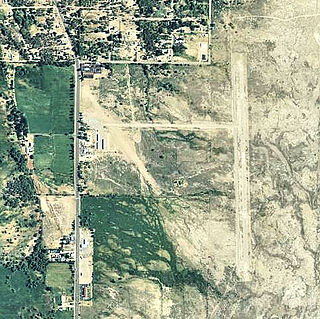
Lone Pine Airport is a public airport located one mile (1.6 km) southeast of Lone Pine serving Inyo County, California, United States. The airport has two runways and is mostly used for general aviation. Services include air ambulance for the southern part of the county, and search and rescue for Mount Whitney and Death Valley.

The Darwin Falls Wilderness is a protected area in the northern Mojave Desert adjacent to Death Valley National Park. The 8,189-acre (3,314 ha) wilderness area was created by the California Desert Protection Act of 1994 and is managed by the Bureau of Land Management as part of the National Wilderness Preservation System.

Darwin Falls is a waterfall located on the western edge of Death Valley National Park near the settlement of Panamint Springs, California. Although there exists a similarly named Darwin Falls Wilderness adjacent to the falls, the falls themselves are located in and administered by Death Valley National Park and the National Park Service. There are several falls, but they are mainly divided into the upper and lower, with a small grotto in between. At a combined 80 feet (24 m), it is the highest waterfall in the park. The canyon is walled by dramatic plutonic rock.
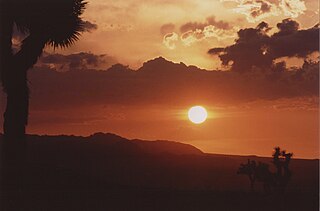
The High Desert is a vernacular region with non-discrete boundaries covering areas of the western Mojave Desert in Southern California. The region encompasses various terrain with elevations generally between 2,000 and 4,000 ft above sea level, and is located just north of the San Gabriel, San Bernardino, and Little San Bernardino Mountains.

Forest Falls is an unincorporated community in San Bernardino County, California, 75 miles (121 km) due east of Los Angeles. The community has a population of 1,102 and contains 712 houses. Forest Falls is best known for the waterfalls on Vivian and Falls creeks and as a point of access for recreation in the San Bernardino National Forest, particularly the San Gorgonio Wilderness Area, which lies directly north of the community.

Riverside County is a county located in the southern portion of the U.S. state of California. As of the 2020 census, the population was 2,418,185, making it the fourth-most populous county in California and the 10th-most populous in the United States. The name was derived from the city of Riverside, which is the county seat.
Rainbow Canyon is a canyon inside Death Valley National Park in Inyo County, California, on the park's western border. It is about 130 miles (210 km) west of Las Vegas and 160 miles (260 km) north of Los Angeles.